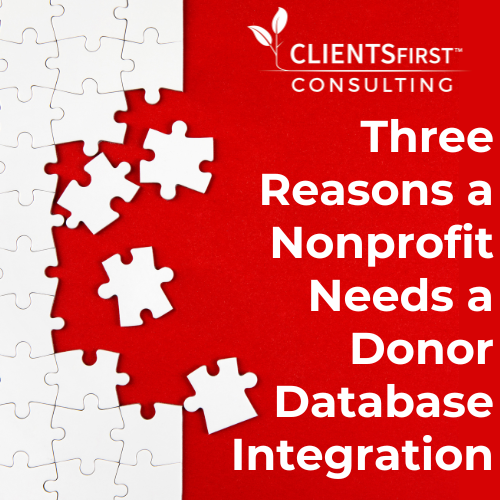Three Reasons a Nonprofit Should Have a Donor Database Integration

Even though the nonprofit business model is built around forging strong relationships and lasting connections, there is probably no other industry with more disconnected data systems than nonprofits. Too often we hear complaints from marketers and business developers struggling with challenges caused by juggling so many disconnected data silos, including the donor database, email marketing systems, corporate partner databases, and more. And don’t even get me started on the spreadsheets.
Database Integration: When, Where and Why
When systems are not connected it causes frustrating challenges such as vast sets of duplicate contacts and repetitious data entry. Staff and business developers are often stuck wasting time on tedious manual tasks such as repeatedly entering the same data into multiple disconnected systems – time that should otherwise be spent communicating with donors or procuring donations. These data silos keep attorneys from effectively analyzing the data to make informed, timely decisions.
As nonprofits transition to digital-first strategies, they are developing new ways to bridge the gaps between these disconnected silos through system integrations, allowing for a more enhanced flow of information.
While there are many ways to integrate your data systems with your donor database, here are a few of the most beneficial integrations when it comes to marketing technology:
1. eMarketing Data
The value of a donor database can be exponentially increased with the integration of an email marketing system. When integrated properly, these tools can connect critical data to your contacts and give you better insight into how they interact with your email or marketing communications. Many times, these integrations have been pre-built by system providers, offering huge cost savings for nonprofits that implement them. Additionally, the data from an eMarketing system can help drive system adoption and provide added value, which most nonprofits struggle to achieve.
2. External Data Sets
External data sets, like company news, information, and donor match programs, can be connected to the nonprofit donor database and to companies and contacts within the database. This type of connection can be extremely beneficial as it can help generate insightful reports on data coming into the database, like newly added companies, job changes or business development activities. Still, it often requires a meticulous initial matching and tagging process and an ongoing subscription cost to prevent the data from becoming outdated.
3. Human Resources Data
Integrating the nonprofits HR system can also provide additional value. This connection can automate the creation of new user accounts in the database, simplifying the onboarding process. The HR data can also be used to feed organization directories and provide computer or mobile access to the information of the nonprofit’s key personnel. Team members can also be related to donors, businesses, prospective clients or opportunity records.
Focusing on an integration strategy can provide nonprofits with a solid foundation for Donor Database success. However, this is only the first step. The next steps involve addressing the people and process issues, including the daunting change management challenges that are inherent in donor databases. For almost 20 years, the team at CLIENTSFirst Consulting has been helping nonprofits, professional services firms and other organizations successfully select, implement, and integrate CRM, eMarketing, Donor Databases and other marketing technology systems to maximize value, adoption and return on investment. If you need help with CRM Success, please contact us at 404-249-9914 or Info@ClientsFirstConsulting.com.

